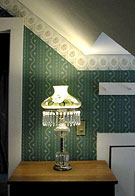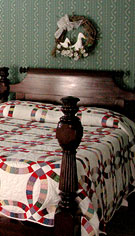|
|
|
Drummer's Room
|
| |
BRASS BED - Mahogany - rolling pin headboard with 4 carved
posts, circa 1800
DESK - Cherry and Walnut Plantation Desk with flip-down top
TABLE - Drop-leaf Oak, English scalloped and barley twist legs
NEEDLE, EMBROIDERY & RIBBON CASES - Are from Griffin Dry Goods Store and were
used during their 117 years of business
|
|
|
During the late 1800's and early 1900's, the Kintner House was
frequently occupied by traveling salesmen, or "Drummers", as they were called at
the time. The drummers kept the local stores supplied with merchandise. Before
1883, the drummers, who usually traveled by riverboat, would arrive in Corydon
by stagecoach. After 1883, most drummers came in on the local train. They
carried trunks or "drums" full of merchandise. After establishing headquarters
in the Kintner House, they would set out their wares for the merchants to view.
Orders were placed for appropriate items which were delivered at a later date.
The drummers often hired a horse and carriage to call on stores throughout the
county.
Among the prominent department stores in Corydon's turn of the century
history were W.H. Keller and Co., C.P. Trotter's "The Hub", and Griffin's Dry
Goods.
Keller's was the largest department store in Corydon for fifty-three years.
Established in 1879 by W.H. Keller, the store originally sold only groceries.
Mr. Keller's business was conducted in an unpretentious frame building at the
Northwest corner of Capitol and Beaver Streets. In 1881, he added dry goods,
clothing, boots, and shoes. In 1894, Will Keller decided to erect a new building
and expand his business. The old frame building was moved into the middle of
Beaver Street until the new, two-story, modern brick structure was complete.
In 1895, W.H. Keller decided to bring his brothers Leonard C. Keller and
Edward G. Kellerinto a partnership. The three brothers were joined by Thomas J.
Hudson, a brother-in-law of W.H. Keller. The partners established the motto "We
four and no more". W.H. Keller  and Leonard managed dry goods, carpet, and ladies
cloaks. Edward oversaw the clothing and furnishings departments. Hudson was in
charge of boots, shoes, and hats. In addition to the retail trade, the firm
owned eight huckster wagons which traded merchandise in four counties
surrounding Corydon. Another wagon made trips to Louisville selling the large
supply of farm producewhich Keller's collected. Smaller wagons made deliveries
of groceries twice daily throughout Corydon. and Leonard managed dry goods, carpet, and ladies
cloaks. Edward oversaw the clothing and furnishings departments. Hudson was in
charge of boots, shoes, and hats. In addition to the retail trade, the firm
owned eight huckster wagons which traded merchandise in four counties
surrounding Corydon. Another wagon made trips to Louisville selling the large
supply of farm producewhich Keller's collected. Smaller wagons made deliveries
of groceries twice daily throughout Corydon.
The four partners incorporated the business in 1903. A new enterprise was
added, which was the manufacturing of wagons and spokes. That business evolved
into the present "Keller Manufacturing", which is the largest manufacturer of
dining room furniture in the country.Will and Edward eventually took over
management of the new manufacturing company while Leonard became manager of the
dry goods store with Mr. Hudson in assistance. W.H. Keller died in the fall of
1923. The following year, Leonard C. Keller became the sole owner of Keller's
Dry Goods. He died in 1927 and his family continued operating the store for five
years. In 1932, the Keller family closed out the retail store and sold the
building.
In October, 1894, Charles P. Trotter and Robert Gibson organized "C.P.
Trotter and Co.", and ran a mercantile business known as "The Hub". Within the
store's first year of business, Mr. Trotter purchased a new three-story building
on Beaver Street facing the town square. The upper two floors were leased as
apartments and offices and "The Hub" occupied the ground floor. The store sold
hats, boots, shoes, notions, clothing, jewelry, mattings, franite and aluminum
ware, window shades, trunks, calises, umbrellas, parasols, "fancy goods",
gentlemen's furnishing goods, lamps, table cutlery, pictures, and other high
quality goods. The great variety of merchandise and prices suited the tastes of
their customers.
Robert Gibson retired, and The Hub continued to flourish under the management
of C.P. Trotter until he was 71 years old. In 1928 he sold  his stock of
merchandise to Meyer Gladstein who was operating a ready-to-wear business on Elm
Street. Trotter sold the building in 1930 to Louis Berlin who opened a
department store in the location. The building was renovated by the Kintner
House, Inc. in 1986. his stock of
merchandise to Meyer Gladstein who was operating a ready-to-wear business on Elm
Street. Trotter sold the building in 1930 to Louis Berlin who opened a
department store in the location. The building was renovated by the Kintner
House, Inc. in 1986.
The Griffin family of Corydon operated a dry goods store in the town square
for 117 years. Their first store was opened by Patrick Griffin and his
brother-in-law Thomas McGrain in 1865 in the "Applegate Building" on Beaver
Street. Patrick had left Corydon for California during the Gold Rush, where he
and his brother opened a trading post. Following the Civil War, Patrick returned
to Corydon where he put his expertise to work in "Griffin and McGrain". In 1868,
they bought the east end of the block and built a two-story brick building. The
two men sold dry goods, footwear, furniture, organs, and groceries for about
twenty years before closing the business.
On February 6, 1897, Patrick opened a new dry goods store in his original
location in the Applegate Building. It was opened in his son's name, and was
thereafter known as "Maurice Griffin and Company". The store was stocked with a
wide variety of merchandise including notions, fabrics, hosiery, shoes, hats,
and clothing.
In 1920, the Griffins bought the building from Media Applegate Miller and the
business was expanded to the second floor. Maurice was joined by his four
sisters in operating the store. One sister, Olive, had a talent for making hats.
She studied the craft in Louisville and operated the store's millinery
department for many years. She kept a large stock of basic hats along with
plumes, bows, lace, flowers, and other items required to trim them.
Frederick P. Griffin, Maurice's son, was the third generation of Griffins to
manage the family store. He continued in the dry goods business on the square
for thirty years. In 1983, the stock was closed out, and the business closed.
Fred Griffin sold the building in August, 1986 to the Kintner House, Inc. and
currently it is occupied by the Griffin Building Antique Mall.
|
|